Plasterboard TV niche: design options
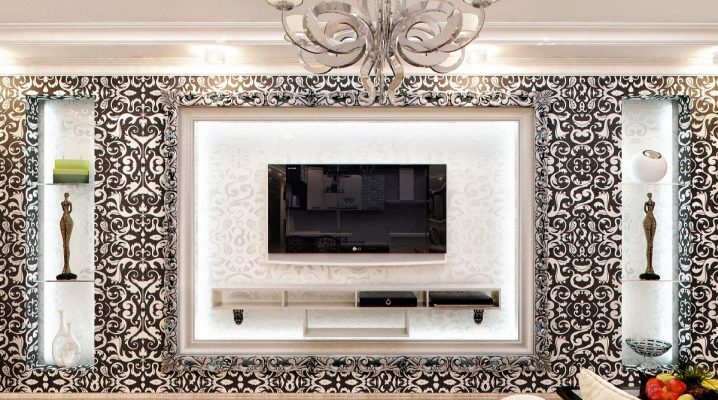
A drywall niche is a great idea for a living room, bedroom, or kitchen. This design solution has a lot of variations and manufacturing methods. Even inexperienced craftsmen will be able to build a niche that can refine the existing interior and emphasize its colors and materials favorably.
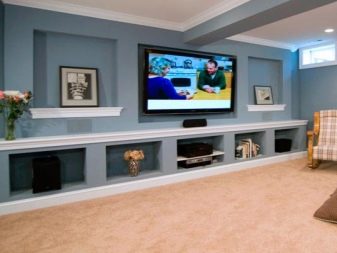

Features and Benefits
A home-made niche for a drywall TV (GKL) can be both spectacular and functional at the same time. You can determine the size, number of compartments, color and shape yourself, linking all interior elements together in this way. Inside, you can easily hide the wires, and additional lighting will add the necessary accents.


The advantages of such a solution are as follows:
- a similar niche in almost any design will be cheaper than custom-made cabinet furniture;
- installation does not take much time even for a novice builder;
- with proper design, the niche will look expensive and neat;
- a decorative recess will protect the TV from falling;
- a niche replaces hinged shelves, bulky cabinets and stands that eat up a lot of space;
- ideal for zoning space without the use of partitions or large cabinets;
- in addition to the TV, you can mount an acoustic system in a niche, getting a full-fledged home theater;
- noise insulation is an additional bonus to all the existing pluses.

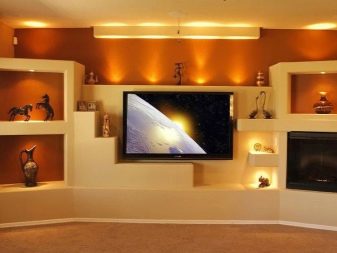
This design has a drawback, but perhaps only one: visually, the room looks smaller.
However, plasterboard niches are often installed in the middle of the room just for the purpose of dividing the space.
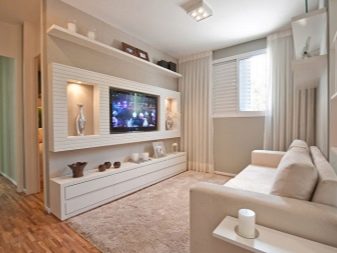

Models
Among the many popular forms of TV niches, the most popular are three.
- Wall. Looks like a full-fledged wall with TV recesses and decorative elements.
- Fireplace. A decorative fireplace is placed under the TV, which can be decorated with additional lighting for greater comfort. The fireplace can also function as a chest of drawers under the TV.
- Window. A multi-level hinged structure creates a kind of portal in the living room.



Lighting plays a very important role in the appearance of the final structure. The safest solution would be spotlights or LED strip. You can achieve a chic effect with neon threads. They are usually placed behind equipment and around the perimeter of a niche. With this design, it is worth considering that the light should not be directed into the room, otherwise it will look too bright. The same goes for spot lamps.


The optimal shade of light is warm yellow or white. Neon colors (red, blue, green) are best turned on only while watching TV.
You can also cut original figures in drywall, creating a kind of frame around the TV. In backlight mode, interesting shadows will appear.
A corner niche also has a place to be, but it assumes a large area of \ u200b \ u200bthe room, otherwise the structure may look bulky.
The TV stand has long lost its relevance, because niches are becoming more and more popular. This is not surprising: ease of installation and manufacture and inexpensive material play a role.




Interesting design solutions
Before starting work, you need to think over the project in terms of the design of the entire room and its dimensions.
Variations in design solutions can be as follows:
- recess with arcuate elements;
- square or rectangular depression;
- niche with additional shelves for decorative vases, books, speakers, etc.
- backlit niche.
By the method of location in the wall, one can distinguish open (a large ledge in the wall, on the back wall of which the TV is placed) and built-in (the TV does not protrude forward, but is completely built into a niche) recesses.




Quite popular is the design idea in the form of a niche, the design of which occupies the entire space from the ceiling to the floor itself. In this case, you can customize the section of the wall behind the TV, combining it with the color of the walls in the room.
You can also build a decorative niche in the form of a wardrobe, and hide the TV behind a curtain or door.
Often in classic interiors, plasterboard niches for TV are decorated with artificial stone. It is attached to liquid nails or assembly glue. For high-tech style, this solution will not work. Most often, decorative niches in the form of a fireplace are decorated with stone.
It is important to remember that the TV and the fireplace should not visually "press" on each other, that is, they should be of approximately the same dimensions.




The TV itself is sometimes framed. This is a job for professionals from framing shops, but with a strong desire, you can try and do something like that yourself.
An excellent option would be to decorate the wall behind the TV with pictures. Such a solution can be incorporated into any interior, because the choice of frames and the paintings themselves is limited only by imagination. But if there are not enough good ideas for the selection and combination of paintings, there is an easier solution - ready-made vinyl stickers. They can be of any size and shape: in the form of animals, plants, a model of a city, or just geometric shapes. Here you need to try to find the best option for the design of a particular room.


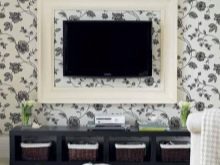
If you want something unusual and unique, decorate the wall behind the TV with bamboo. Such a canvas in an eco-friendly style will fit into almost any interior.
Often, textiles are also used to decorate niches. It is best to use natural fabrics that match in color with furniture and wallpaper. If construction is the centerpiece of a room's design, contrast will also be appropriate.



Self-production
Making a drywall niche with your own hands is not as difficult as it seems. By following simple instructions step by step, you can manage it in a couple of days. The result is much more pleasant to admire when you know that you have made such beauty without the help of repair specialists.
- First you need to determine the location of the niche and its size. It is necessary to measure the desired area, make sure that the TV will enter there without problems, and make a markup. For greater clarity and understanding of the process, you can draw up drawings. It should not be forgotten that the TV should not come in close, it is better to leave some free space for ventilation and subsequent more convenient cleaning.

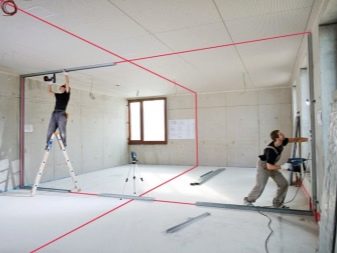
- It is not necessary to dwell on a rectangular notch. The shape can be any - think about which one will emphasize the interior more profitably.
- Further, in accordance with the applied markings, you need to install the guide profiles, securing them with self-tapping screws. Such profiles are made of steel tape and serve as a frame for fixing the gypsum board.
- Then you can run wires from the TV, the socket and indoor lights, if provided.
- The next step is to install the drywall. When cutting parts, you need to ensure that the joints coincide with accuracy and that there are no protrusions or indentations anywhere, even small ones.



- Along the perimeter of the resulting plasterboard sheets, you need to install additional profiles (the same size as those that were installed earlier). This is necessary for additional durability of the product. Using self-tapping screws, we fasten all the parts to the guide profile.
- It remains to complete the finishing of the niche.This is filling joints, priming, sanding, painting, installing lighting and any other necessary finishing in a particular case.
- When the finishing work is finished, you can hang the TV. Usually, the kit includes brackets that need to be attached to the drywall with dowels.
- And, of course, the decor. Candles, decorative figures, vases, flowers, paintings and photographs - it all depends only on resourcefulness and imagination.



Useful Tips
- If the room is in a classic style, symmetrical shelves and recesses will look best. This will help the whole composition look more static.
- Asymmetry will be appropriate in minimalism and hi-tech. Here you can hang the TV off the center of the wall. This option is more often used in rooms divided into zones.
- It is important even before starting work to decide whether the TV will stand on a stand or hang on the wall. The size of the niche will depend on this.
- Play with color - if the room is dominated by light tones, then the niche should be darker by several tones, and vice versa.



- If you have a lot of time and a desire to make your niche original and unique, then a mosaic pattern will be the ideal solution. Such work may take more than one week, but the result will definitely exceed all expectations.
- Flowering shrubs around the perimeter will become less complex, but no less beautiful decorative elements.
- When drawing up a drawing and a work plan, for convenience, you can divide the wall equally with a pencil, having outlined the contours of the future niche in advance.


- There are several types of drywall. For any niche, the first step is to choose a moisture resistant option. The choice of the desired thickness should already be based on the shape and dimensions of the niche, as well as the weight of items for decorating the shelves.
- Some of the wiring can be routed under the skirting board. Modern plastic models just assume this use.
- It is often more convenient to first completely assemble the frame, and then attach it to the wall.
- If the niche goes all the way to the floor, then wall mounting rails are probably not enough. From below, all parts of the structure should also be fixed.

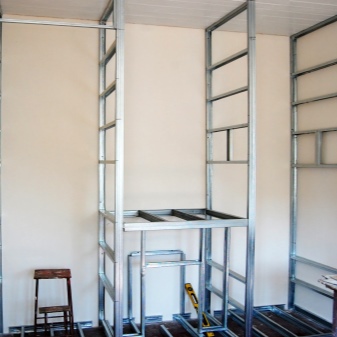
- If the finish includes wallpapering, it is advisable to prime the entire niche with a primer for better adhesion.
- It is better not to use a wall with a window for the construction of a niche, since it is possible to disrupt the lighting in the room.
- Even at the planning stage, it is necessary to take into account the location of all outlets, as well as think over which of them will be used and where the electrical wires will run.
- When calculating the dimensions of a niche, remember that after a while, you may acquire another plasma of a larger size. But even if the new technique does not fit into the existing "framework", this will only become another reason to start a small construction site again and show imagination and ingenuity in a new style.

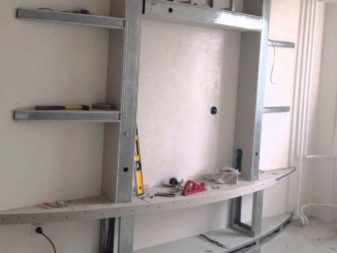
- Don't be afraid to use wood for decoration. It will take more time than just painting or putty, but it will add warmth and comfort to the overall picture.
- If you use pieces of glass or mirrors to decorate a niche, all safety measures must be followed. It is best to use a thick cloth bag (or preferably several) and a hammer for crushing. Make sure that small debris does not spread across the floor after finishing work. It is better not to let pets into the room during finishing work.


Beautiful examples for inspiration
- A great example of minimalist design is the long drawer unit and simple, parallel shelves.
- In this example, the artificial stone finish stands out against the background of the room, but it looks very appropriate and original.


- Lovers of the classic interior will love the openwork frame framing the TV. It is unlikely that a non-professional will be able to make something like this on his own, but framing workshops will come to the rescue.
- A niche with a fully built-in TV looks very stylish.Such a design, however, can visually reduce the space of the room, so it will be ideal only in large rooms.


- Another option for decorating a niche in the hall. Everything is intertwined here: stone, shelves, fireplace, and a small cabinet.
- A construction with a natural wood finish looks very expensive and of high quality.


- The arched shapes add softness and warmth to the entire interior. It does not look as strict as rectangular and square niches.
- And here is an option for placing a niche for a TV in the kitchen. It does not take up much space and does not stand out from the general view.
- Decorating with pictures is ideal for a niche in the bedroom.



- The TV in the kitchen can also fit very organically right above the work surface so that you can watch cooking shows and cook at the same time.
- Finishing in the form of a solid wooden canvas looks very interesting. Such a design will fit well into the living room with both classic and minimalistic styles.
- Few people do this, but a low niche can be placed directly opposite the window. With a successful combination of furniture, wallpaper and decor items, this will look very unusual.



For information on how to make a niche for a TV out of drywall with your own hands, see the next video.













The comment was sent successfully.